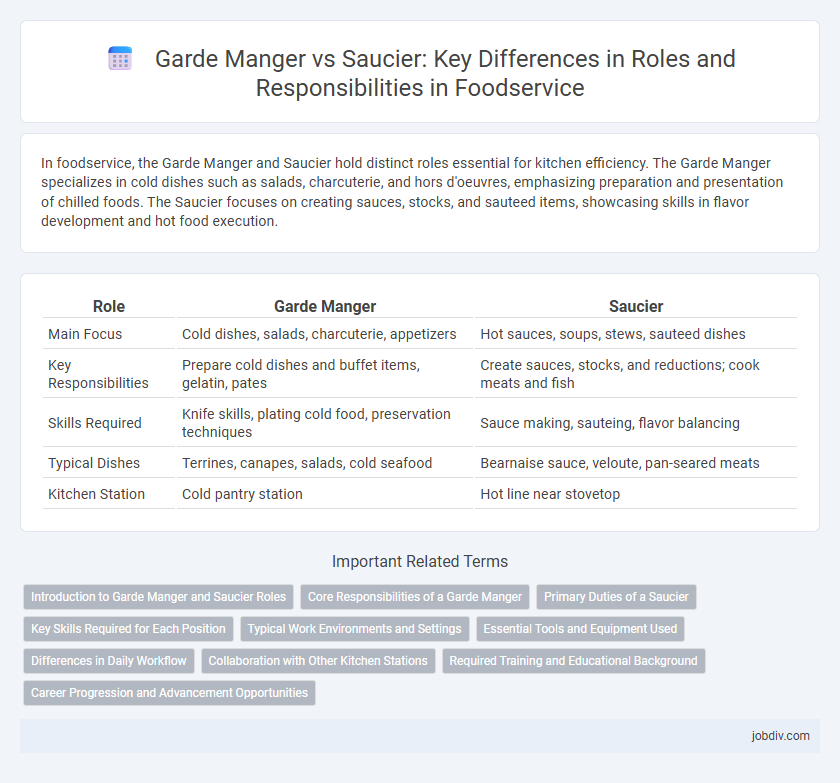In foodservice, the Garde Manger and Saucier hold distinct roles essential for kitchen efficiency. The Garde Manger specializes in cold dishes such as salads, charcuterie, and hors d'oeuvres, emphasizing preparation and presentation of chilled foods. The Saucier focuses on creating sauces, stocks, and sauteed items, showcasing skills in flavor development and hot food execution.
Table of Comparison
| Role | Garde Manger | Saucier |
|---|---|---|
| Main Focus | Cold dishes, salads, charcuterie, appetizers | Hot sauces, soups, stews, sauteed dishes |
| Key Responsibilities | Prepare cold dishes and buffet items, gelatin, pates | Create sauces, stocks, and reductions; cook meats and fish |
| Skills Required | Knife skills, plating cold food, preservation techniques | Sauce making, sauteing, flavor balancing |
| Typical Dishes | Terrines, canapes, salads, cold seafood | Bearnaise sauce, veloute, pan-seared meats |
| Kitchen Station | Cold pantry station | Hot line near stovetop |
Introduction to Garde Manger and Saucier Roles
Garde Manger specializes in cold food preparation, including salads, pates, and charcuterie, ensuring high-quality presentation and flavor balance. The Saucier focuses on creating sauces, stocks, and sauteed dishes, playing a crucial role in enriching the taste and texture of hot entrees. Both positions require expert culinary skills and deep knowledge of ingredients to support seamless kitchen operations in professional foodservice environments.
Core Responsibilities of a Garde Manger
The Garde Manger specializes in preparing cold dishes such as salads, charcuterie, pates, and hors d'oeuvres, ensuring precise presentation and flavor balance. Key responsibilities include managing cold food stations, preparing ingredients in advance, and maintaining strict hygiene standards to preserve freshness. This role requires expertise in food preservation, artistic plating, and coordination with other kitchen teams for timely service.
Primary Duties of a Saucier
The primary duties of a Saucier in foodservice involve preparing sauces, stocks, and soups, as well as sauteing meats and vegetables to enhance flavor profiles. This chef is skilled in precise seasoning and timing to ensure the balance and richness of each dish. Unlike the Garde Manger, who handles cold dishes and charcuterie, the Saucier focuses exclusively on hot preparations essential for main courses.
Key Skills Required for Each Position
Garde Manger chefs excel in cold food preparation, requiring expertise in charcuterie, pates, and intricate plating techniques that emphasize aesthetics and texture. Saucier chefs specialize in sauce creation and meat preparation, demanding mastery in flavor balancing, reduction techniques, and precise cooking methods to enhance main dishes. Both roles require excellent knife skills, knowledge of ingredients, and a strong understanding of kitchen organization to ensure efficiency and quality.
Typical Work Environments and Settings
Garde Manger chefs typically work in cold kitchen environments such as banquet halls, hotels, and fine dining establishments, specializing in salads, charcuterie, and cold appetizers. Saucier chefs are primarily found in hot kitchens within upscale restaurants and hotels, focusing on preparing sauces, soups, and sauteed dishes. Both roles require collaboration with executive chefs but operate in distinct kitchen sections tailored to their culinary expertise.
Essential Tools and Equipment Used
Garde Manger chefs rely on essential tools such as mandolines, paring knives, and terrine molds to prepare cold dishes and charcuterie with precision. Saucier chefs utilize heavy-duty saute pans, sauce pots, and immersion blenders to create complex sauces and reductions integral to hot dishes. Both stations require high-quality thermometers and plating tweezers for accuracy and presentation in foodservice kitchens.
Differences in Daily Workflow
The Garde Manger primarily manages cold dishes, including salads, charcuterie, and appetizers, requiring meticulous prep work and precise plating each shift. The Saucier specializes in sauces, stocks, and sauteed items, focusing on cooking techniques that ensure rich flavors and proper texture consistency throughout service. While the Garde Manger's workflow revolves around chilling and raw ingredient assembly, the Saucier's tasks demand continuous heat management and timing to synchronize with main courses.
Collaboration with Other Kitchen Stations
The Garde Manger collaborates closely with the Saucier to ensure seamless integration of cold preparations with hot sauces and plated dishes, enhancing overall flavor profiles. Effective communication between these stations allows for timely delivery of sauces that complement charcuterie, salads, and cold appetizers. This teamwork optimizes kitchen workflow and ensures consistent quality across the entire menu.
Required Training and Educational Background
Garde Manger chefs typically require specialized training in cold food preparation, including charcuterie, pates, and salads, often obtained through culinary school programs focused on cold kitchen techniques. Saucier chefs need comprehensive knowledge of sauce making, stocks, and cooking methods, usually acquired through classical culinary education emphasizing hot kitchen skills and sauce development. Both roles benefit from formal culinary certifications, but the saucier's training prioritizes heat management and flavor balancing, while the garde manger emphasizes preservation and presentation of cold dishes.
Career Progression and Advancement Opportunities
Garde Manger chefs specialize in cold dishes such as charcuterie, salads, and pates, offering foundational skills that can lead to roles in culinary management or specialized catering. Saucier chefs, responsible for sauces and hot dishes, typically gain expertise that positions them for advancement as sous chefs or executive chefs due to their mastery of complex cooking techniques. Career progression from Garde Manger to Saucier or higher kitchen stations often depends on skill development, experience, and leadership abilities within professional kitchens.
Garde Manger vs Saucier Infographic

 jobdiv.com
jobdiv.com